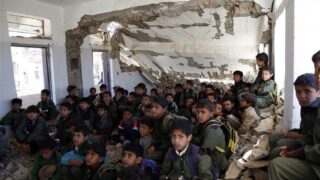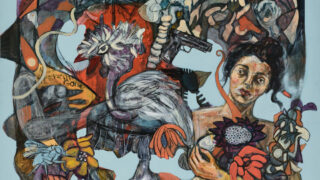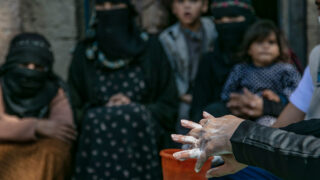
This publication has benefited from the support of the Rosa Luxemburg Foundation. This text may be reproduced in part or in full, provided the source is acknowledged.
In February 2021, Yemenis were shaken by the story of Al-Anoud, a 19-year-old girl who now sat with her right palm on her mouth, hiding her disfigured lips, while her left hand rests in her lap, uncovering burn clusters. The young woman told her story with a different mouth and different lips. She recounted how her ex-husband had deformed her by laughingly pouring acid over her face, resulting in melting off a large part of her face and the loss of her left eye. His reason for doing so was that Al-Anoud divorced him when she was 16 years old. He had married her when she was only 12, enslaved her - as she described it - hit her and sexually assaulted her after chaining her up. Did Al-Anoud survive? Nothing can heal the wounds she’s been through, and, while her story has reached many and was met with a sympathy that thousands of other women who are married off young then silently killed don’t get, what she finally received was no more than her scarred image roaming virtual worlds as a symbol of that pain…
Underage marriages on the rise
According to the UNICEF, (1) more than two thirds of girls in Yemen are now getting married before the age of eighteen, as opposed to fifty percent in pre-war times. Notably, “before the age of eighteen” here often means eight, nine, and ten-year-olds! They are married off or “sold” off to men in their thirties and forties who expect eight-year-olds to grant them their sexual “rights”, be mothers, and housewives. When these girls are unable to keep up with all these demands and expectations, they are often assaulted. The UNICEF report, among others, traces the reasons behind such behaviour back to economic hardships that may drive a father or a legal guardian to marry off their young girls in return for a dowry that would help “meet the family’s needs,” albeit temporarily. They might also marry a girl off to protect her from “perversions” or to give her a better life… Such reasons have always been there, but they don’t tell us everything we need to know about the phenomenon. Before Al-Anoud’s tragedy, there was the story of 12-year-old Hind. Her imprisoned father had tried to marry her off to another prisoner who was sentenced to death, as he had once done with her older sister, whom he gave in marriage to another prisoner. Hind was lucky to have her mother around, who had learned the lesson from what had happened to her first daughter. She fought to obtain an order to void the matrimony attempted by the father, who had been serving time in prison since his daughter was three years old.
Al-Anoud and Hind weren’t the first girls to shock and debunk public opinion. In April 2008, many Yemini women shed tears as they looked at a ten-year old’s picture, smiling kindly and timidly to the camera, while journalists’ microphones surrounded her. Nujood was her name, and the media was there covering her divorce at the courthouse, after the decision was made. Nujood was neither the first or last runaway bride case either, but she was the only one to have fled her husband’s house and directly head to court. The little girl went and waited there until the judge noticed her and curiously asked her what she wanted. She answered him, with the little experience she had: a divorce. Nujood was then rightfully called the “bravest girl in the world”, and the massive media coverage of her story made her case resonate internationally.
Women began that struggle in 2005, which was led then by the Yemeni Network for Combating Violence Against Women. They collaborated with other organizations to launch a campaign to raise awareness of the risks of child marriage and its physical, mental, and social repercussions.
Nujood became the symbolic face of a tragedy that Yemini women know all too well, as do other women on this planet; that of child marriages, which, in certain cases, can be described as human trafficking or child prostitution. With the help of her lawyer, Shatha Nasser, one of the first women to open law firms in the Yemeni capital Sanaa, Nujood became the image and example of a Yemini woman capable of standing up for herself and winning her court case, despite all the intimidation, threats, and the potentiality of failure.
The unstoppable tide
Today, there are countless Nujoods and Anouds in Yemen. On this particular issue of child marriage, the country has experienced much decline rather than progress. The marriageable age used to be 15 years old, as set in the 1992 Constitution, but was then constitutionally amended and replaced with another article that sets no minimum age for marriage. Rather, it sets it for “whenever a girl is ready for sexual intercourse” – an unfathomable criterion! As such, in the context of war, disintegration, economic collapse, and an absence of the rule of law, alongside the general state of taking all women’s questions lightly, it is only normal that the rate would go up from half to two thirds, and potentially even higher.
Nujood’s divorce in 2008 was an episode in a long series of women’s struggle for determining a safe marriageable age. That was a battle that Yemeni women took upon themselves since before Nujood. Women began that struggle in 2005, which was led then by the Yemeni Network for Combating Violence against Women. They collaborated with other organizations to launch a campaign to raise awareness of the risks of child marriage and its physical, mental, and social repercussions. (2) In the meantime, the National Committee for Women had published an extensive study about discriminatory laws against women and worked with other organizations and members of parliament on a massive advocacy campaign focused on child marriages.(3)
Civil action has continued to grow since 2005. A case like Nujood’s and other girls who had received media attention were a success in their own right. Back then, there was ample space for women to manoeuvre within civil society organizations, while the media fully supported them. Those cases were led by women’s institutions, like the Yemeni Women’s Union (YWU) and the National Committee for Women, alongside a number of civil society organizations, like the Sisters’ Arab Forum for Human Rights, the Democratic School, Reporters without Borders, the Yemeni Media Women Forum, Hood, Siyaj Child Protection Organization, and so on. Most of these were women’s organizations or women-led organizations.
Today, there are countless Nujoods and Anouds in Yemen. On this particular issue of child marriage, the country has experienced much decline rather than progress. The marriageable age used to be 15 years old as set in the 1992 Constitution, but was then constitutionally amended and replaced with another article that sets no minimum age for marriage. Rather, it sets it for “whenever a girl is ready for sexual intercourse” – an unfathomable criterion!
The way in which women placed pressure on legislation that would determine a safe marriageable age for girls was both effective and fierce. They stood together under the same banner, and left no stone unturned in their search for a gateway. They led advocacy campaigns in which male members of parliament participated, organized recurrent demonstrations that marched through the capital, Sanaa, and mobilized the Children’s Parliament and girls’ schools in collaboration with the department of education. They collected signatures from every corner: from streets, schools, wedding parties, from the capital city and all the way to the distant rural villages. Women mobilised the press for support, brought in twelve and fourteen-year-olds to the parliament, distributing flowers to MPs with messages saying: Thank you for protecting my future.
It was an unstoppable tide.
An inoperative parliamentary law
In February 2009, women managed to make the parliament discuss a legal amendment that determined a girl’s marriageable age at 17 years. (4) Although demands sought to set the minimum age for marriage to be 18, in accordance with international criteria, due to severe opposition, 17 was agreed upon instead. That was a huge victory for women, civil society, and women working in civil society organizations. Most members of parliament agreed on that age limit, but added an exception that allowed women under the age of seventeen to be married off, in case one of the judges saw that it was in the girl’s best interest and to her benefit! (5)
Despite that consensus and all the mobilization carried out, the legislation couldn’t be passed, following the objection of a number of MPs and their demand to re-deliberate the law. (6) These MPs were backed by a number of religious figures who openly opposed the question and who, in turn, mobilized women in the streets to object to the mere idea of proposing a law that determined a safe marriageable age, considering it to be in violation of Islamic Sharia and “depriving young men capable of marriage” (!) as Sheikh Mohammad al-Hazmi wrote back then. (7)
The way in which women placed pressure on legislation that would determine a safe marriageable age for girls was both effective and fierce. They stood together under the same banner, and left no stone unturned in their search for a gateway. They led advocacy campaigns in which male MPs participated, organized recurrent demonstrations that marched through the streets of Sanaa, and mobilized the Children’s Parliament and girls’ schools in collaboration with the department of education.
In February 2009, women managed to make the parliament discuss a legal amendment that determined a girl’s marriage age to 17 years. That was a huge victory for women, civil society, and women working in civil society organizations. The legislation couldn’t be passed, though, following the objection of a number of MPs and their demand to re-deliberate the law, backed by a number of religious figures who openly opposed the question, considering it to be in violation of Islamic Sharia.
Disputes were in full swing. Those opposed to the minimum age played the same broken record: “The prophet married Aisha when she was nine” and “this is all the result of foreign incitement directed at our beliefs and culture”. And so, women found themselves facing not only unjust laws and bounded traditions, but also those thoughts deeply entrenched in collective mindsets. During a street debate, one of the campaign activists at the time, Belquis al-Lahabi, responded to a man brandishing the Aisha case by asking him: “and what about Khadija? Shouldn’t she be a role model too?” For my part, I remember how in 2010 I yelled into the face of a man who was trying to provoke me during a demonstration, asking him if he thought he, too, were a prophet who had the right to marry a nine-year-old child!
Women’s great role
The setback, which took place in early 2009, didn’t stop women; rather, the campaign and the counter campaign persisted. Back then, civil and journalistic action was at its peak in Yemen, and women were in the forefront. Women had taken on almost all national questions back then, and not only those related to women. Women stood up for the most prominent, sensitive, and hot cases of the time, from the Saada war to the Jaashen case,(8) from the forcefully disappeared to the constitution amendments, and from political and rights-based freedoms to fighting corruption. Women’s faces were all over the newspapers and television channels and much more: they filled the streets.
The revolution
In early 2010, the movement was still ongoing and women demanding a minimum marriageable age were still out on the streets. The pressure to reopen the case in parliament persisted. That year, for instance, women protested twice before the parliament. They weren’t concerned about local child marriages only, but also about Yemen then turning into a hotbed for what may be called marriage tourism – where tourists, mostly from Saudi Arabia, would visit Yemen and legally marry minor girls, then leave them off to an inevitably horrible fate. Nujood’s story, public uproars, the reverberating media coverage, and the stories of ten and twelve-year olds who died in horrific ways following “legal” rape or because their little bodies couldn’t handle pregnancy and child birth, were all unable to deter “legal guardians”; rather, the numbers kept rising.
Setbacks
Following pressure, the case was reopened in parliament in 2010; a bill was proposed for discussion. By then, the team that previously opposed 18 for a minimum age but agreed on 17 instead had completely distanced itself from the former agreement and became completely opposed to determining any age for marriage. As such, the law was referred to the legislative committee in the Yemeni parliament, which, in turn, issued a 14-page document in which it refused to set a minimum age for marriage, considering the latter to be in “opposition with the Quran, custom, Constitution, and children’s best interest” (9) (!)
Women found themselves facing not only unjust laws and bounded traditions, but also those thoughts deeply entrenched in collective mindsets. During an open street debate, one of the campaign activists at the time, Belquis al-Lahabi, responded to a man brandishing the Aisha case by asking him: “And what about Khadija? Shouldn’t she be a role model too?”
In the meantime, women intensified their protest. In May 2010, tens of thousands of women took to the streets of Sanaa, holding banners and sharing stories of victims of child marriages. They were headed by the chair of the Yemeni Women’s Union (YWU), who announced that she was holding a petition that contained a million signatures, representing the entire spectrum of the Yemini population. (10) Those who supported child marriage took to the streets in response. In one of the protests, in which schoolgirls participated, Islamists mobilised their own teachers’ union and sent their male teachers into the women’s demonstration, where they assaulted girls and women both verbally and physically. (11)
Then came 2011, inevitably assembling all the civil action that had been ongoing for years. Yemeni women were its makers and “minesweepers”, as Belquis al-Lahabi described them. To others, seeing Yemini women take to the streets, not only courageously and in great numbers, but also as leaders of the movement, was truly astonishing. For the women, this was no extraordinary event. They’ve always been there, doing what they do! The only difference this once was that the media was finally showing them as they are. They led protests in the streets, mobilized crowds, made speeches in squares, and urged the tribes to join the revolution, non-violently, leaving their arms at home, pleading “Help! Your sons are being killed in the streets!” When then-President Ali Abdullah Saleh threatened that Yemen was going to be “Somalized” (referencing a Somali scenario in the country), Belquis al-Lahabi responded that it was the women who threatened to “Tunisize” the country (referencing Tunis’ positive changes towards women’s rights), in one of the most iconic statements of 2011.
Gains in vain?
Women and their advocates have held the case of child marriages around since 2011 and whatever followed. In 2013, during the National Dialogue Conference, where women made up 30 percent of the participants, an article that set 18 for a minimum age for marriage was approved, following consensus among the main participating powers. It was expected that the government and parliament would later ratify it, and that it would be fixed in the new State Constitution. Civil war would break out shortly after, however, and the issue of child marriage, along with the entire country’s issues, would be set aside, until further notice.
Women have achieved their goal in terms of legislation, which sets a safe marriageable age for girls, even if they were unlucky in seeing it implemented on the ground. While such a victory won’t be taken away once a peace agreement is reached among the warring parties and the establishment of the State, it would require their presence still. It would require showing up at decision-making centres and hubs that would enable women to place pressure in those spaces, as they had done before. And that’s what today’s women have been doing, fighting on more than one front, and resisting more than a single enemy, with death-defying attempts to protect former gains in the context of “radically” traditional and backwards authorities that practice patriarchy in its worst forms, unchecked.
Back then, civil and journalistic action was at its peak in Yemen, and women were in the forefront. Women had taken on almost all national questions back then, not only those related to women. To others, seeing Yemini women take to the streets, not only courageously and in great numbers, but also as leaders of the movement, was truly astonishing. For the women, this was no extraordinary event. They’ve always been there, doing what they do!
One such practice comes in the form of the difficulties that arise when a Yemini woman needs to issue her own passport – as they cannot do so if not accompanied by a male legal guardian, even though this condition appears nowhere in the law. There are numerous stories of Yemini women who have lost their scholarships, couldn’t travel to receive treatment, or otherwise, because the passport official refused to issue their documents without the presence of a male legal guardian. While this legal guardian may be absent, dead, on his deathbed, in another city, or non-existent, none of the reasons would convince the men in the Passport Office. Those men have assumed a traditional custom to be the law, and have applied it to women for fear that the latters would “escape”. And so, a campaign called “My passport needs no guardianship” was launched online. It took over Yemeni social media between August 2021 and March 2022, where women shared their stories and demands and took to the streets in protest in the city of Taiz from whence the campaign was launched.
Women and their supporters pooled their efforts together, and the campaign eventually bore fruit just one day after International Women’s Day. On March 9, 2022, the Internationally Recognized Yemeni Government issued instructions to the Passports Office to give Yemini women their right to receive their travel documents without “any stipulations”, and in accordance with the law.
This was a simple step in the journey of a thousand miles that Yemini women will have to make. It won’t be impossible for them, however. Those who made the 2011 revolution and whatever preceded it happen are more than capable of making history yet again. Those who grew up amidst the destruction and repression and yet managed to create beauty and peace and carry out their own tasks as well as those of their communities, are certainly capable of continuing the struggle. And if Nujood was the world’s bravest girl in 2008, perhaps all Yemini women must be called the world’s bravest women for this entire decade!
The content of this publication is the sole responsibility of Assafir Al-Arabi and Rosa Luxemburg Foundation cannot accept any liability for it.
Translated from Arabic by Yasmine Haj
Published in Assafir Al-Arabi on 09/06/2022
1- “After Years of Civil War, Child Marriage Is on the Rise in Yemen”. https://bit.ly/39aqpc8. [In Arabic].
2- “A divorced ten-year-old child in second grade: I couldn’t live a normal life”.
https://www.alwatanvoice.com/arabic/news/2009/03/06/135672.html. [In Arabic].
3- A phone interview with Belquis al-Lahabi in May 2022.
4- “Determining the legal marriageable age for girls is cause for relief in Yemen”. https://bit.ly/3mb7LUb. [In Arabic].
5- “Yemen: Little girls encaged in marriage, and a legislative controversy that eventually buries alive a bill to set a minimum age for marriage. http://www.althawranews.net/archives/116889. [In Arabic].
6- “A Yemini girl dies due to sexual violence a few days after marriage”. https://bit.ly/3Ml8Kfg. [In Arabic].
7- “Yemini channels and neutrality in paralysis”. https://marebpress.org/articles.php?id=6749. [In Arabic].
8- Al-Jaashen is a region in Yemen located in the south-western part of Ibb Governorate in the south. Their problem is one of the longest standing rights-based questions in Yemen and dates back to the 1970s. the population there suffered from violent attacks by the region’s sheikh, a Shura Council member, Sheikh Ahmad Mansour. He used to own private prisons with the State’s knowledge, stealing people’s possessions, homes, and lands, and forcefully displacing them. Their case resonated widely in the media when civil society organizations adopted their cause, but it wasn’t possible to sue the sheikh as he was protected by the State.
9- “Yemen: Little girls encaged in marriage, and a legislative controversy that eventually buries alive a bill to set a minimum age for marriage”. http://www.althawranews.net/archives/116889. [In Arabic].
10- “Child marriages stir religious controversy in Yemen, and religious scholars prohibit setting a marriageable age”, June 4th, 2010. https://bit.ly/3tdrsPm. [In Arabic].
11- A phone interview with Belquis al-Lahabi in May 2022.







